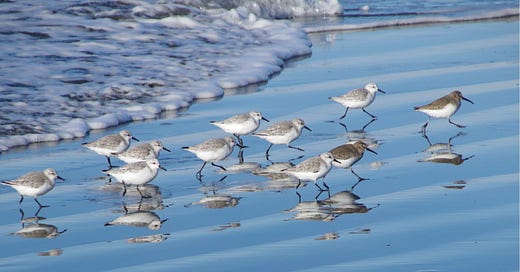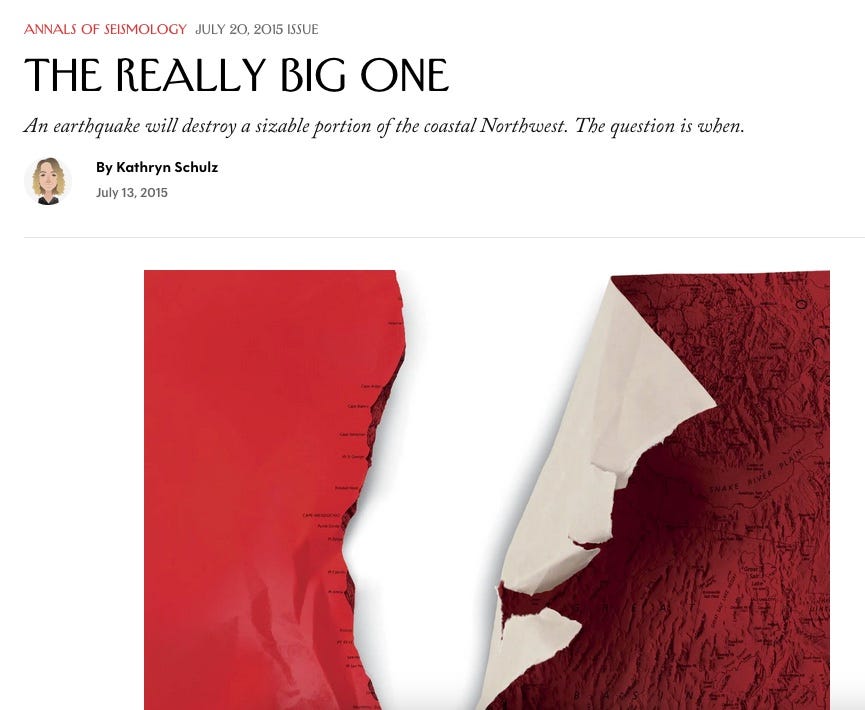Striding sandpipers on the sand at Pacific Beach, WA
Last night I got to share a small table in the back room at Jack & Dan’s tavern near Gonzaga with two delightful geologists, a married couple, who specialize in the study of earthquakes. The occasion was a gathering of the Columbia Basin Geologic Society and, although I’m not a geologist, I was delighted to be there.
Before I go on, it will help to share some bullet points about this:
A) I really like geology.
B) Spokane is situated on the edge of deep geologic time, pretty much right at the coastline of a long ago supercontinent (Rodinia). The geology gods have been really, really kind to Spokane giving us, among other gifts, a magnificent aquifer that flows through billions of tons of water-bearing cobbles delivered by Ice Age floods.
C) We’re in the midst of a golden age in Northwest geology— with some truly outstanding geologists and geology teachers—one of whom, Eastern Washington University’s Chad Pritchard, was hosting last night’s gathering.
D) The fate of Washington state (and Oregon, and Northern California) will be determined by a grim geologic story, an inevitable catastrophic earthquake and tsunami very much like the one that devastated northern Japan in 2011.
I’m really sorry about D), it’s a hard truth to reckon with. But it’s harder to ignore it. So let’s dive in.
My daughter lives in Portland, and my beloved older sister lives in Pacific Beach, on the Washington coast. Not a week goes by that I don’t worry about them because of what geologists only recently discovered about the so-called Cascadia Subduction Zone. Beyond their faces and voices (and those of other people I know and love who live near the coast) I’m aware of the dynamic community that hangs on this thread of time—the life space between now and the inevitable jolt of a massive earthquake, just like the one that struck Japan and (among other things) triggered the Fukushima nuclear disaster. That takes a bit of explanation, so bear with me a bit.
Last night’s talk—Identifying forearc faults in southwestern Washington, Cascadia Subduction Zone—was delivered by Kelsay Stanton a Washington Department of Natural Resources geologist who’s been doing extensive field work not far from where my sister lives. One of her key findings is about what I’ll call the “big bulge.”
This is what worries me and countless others who are reasonably read up on this.
Our lives ride on plates that move at about the rate our fingernails grow. Where plates come together, pressure builds up and this is what’s happening less than 100 miles off the coast, along a 700 mile long rift. There, the North American plate, moving westward, is overriding an oceanic plate—the Juan de Fuca plate—which is moving to the northeast.
The “big bulge” is what is happening atop the leading edge of the North American plate. For reasons geologists don’t yet completely understand—the overriding plate has gotten stuck on the subducting Juan de Fuca plate.
Image promo for Kathryn Schulz’s Pulitzer-winning article from 2015
This is not good. I mean really, really not good.
It is causing the land on and near the coast to buckle upwards, storing energy that will inevitably be released when the elasticity of the crust can no longer withstand the pressure. When that happens the bulge will quickly collapse but also slide dramatically westward, beneath the ocean, as it does. This will kick up an enormous tsunami, a terrible wave that will head both east and west, with the east wave arriving in about 15 minutes on the Pacific Northwest coast.
One of the better and more eloquent explanations for this comes from Oregon State geologist Chris Goldfinger who presented it in a 15-minute TED Talk entitled “Toast, tsunamis and the Really Big One,” that he delivered in June of 2016. For my two cents, it’s one of the best TED Talks ever produced.
The word “toast” in his title comes from an earth-shaking article that appeared in the New Yorker magazine in July 2015. It is entitled The Really Big One and it earned author Kathryn Schulz a Pulitzer Prize for feature writing in 2016.
Goldfinger, an eminent Northwest geologist, is one of the key sources in the article. Research in the past quarter century has produced solid evidence that the Cascadia Subduction Zone triggers big quakes in the southern part of the zone, ranging between magnitude 8 and 8.6 on the Richter scale. The research also shows there have been twice as many of these “big” quakes as there have been “really big” quakes registering category 9.0 or above on the Richter scale. The “big” quakes are partial ruptures of the zone, and the “really big” quakes are full zonal ruptures along the 700 mile length of the subduction zone.
Based on a historical record going back thousands of years, Goldfinger estimates that—over the next fifty years—the chances of a partial zone rupture (the 8.0 to 8.7 magnitude quakes) are roughly one in three, and that the odds of a full-zone rupture, category 9 quake (like the one in 1700 AD) are roughly 1 in 10. Although we are not overdue for a full-rupture event, we are overdue for a partial rupture event. (For more on this, I’m including, below, one of CWU professor Nick Zentner’s signature geology lectures, one prompted by Schulz’s article.)
Schulz’s piece is well-crafted and well-documented. If there is one loose screw in the piece it is a quote from a top regional Federal Emergency Management Agency official who is quoted as saying that FEMA’s operating assumption “is that everything west of Interstate 5 will be toast” when the inevitable category 9 Cascadia earthquake occurs.
The unfortunate “toast” quote seemed to imply that a Cascadia quake-induced tsunami could reach as far west as Seattle, Tacoma, Olympia, and, in Oregon, Portland, Eugene, Salem. It won’t. The damage in those large cities will come only from the powerful earthquake. That damage will depend on several factors. Which is not to say the damage won’t be catastrophic, only to say it won’t be as uniformly catastrophic as the “toast” quote suggests.
Schulz’s article was a genuine public service, a clarion alarm that has already led to some pivotal changes, such as the demolition of the Alaskan Way viaduct in Seattle and its replacement with (one hopes) a quake-proof tunnel. Yet, as Goldfinger glumly notes in his TED Talk, the problem is enormous because the major coastal cities in the Northwest were not built to withstand even modest earthquakes much smaller than the looming Cascadia quakes will be. I use the word “will” purposefully. As Goldfinger says in his talk a devastating Cascadia quake “is now a certainty. It is the most air-tight case in science that I know of.”
So that’s why I wanted to go to Ms. Stanton’s talk last night, to learn the latest on the Cascadia Subduction Zone story from a scientist doing field work on the coast. She did a great job and I learned something about the “big bulge” that I didn’t know before.
On the way toward Jack & Dan’s something happened that I didn’t expect. To freshen my memory, I tried to re-read Schulz’s New Yorker piece. I had to put it down mid-way through. It’s a well-crafted story, but it was literally making me sick, not just about what could very well happen to my daughter or my sister, but to hundreds of thousands of people who would experience what the article so vividly describes.
My memory flashed to the evening of my 50th birthday. I was with my family, in Hawaii. But we were sleeping on the floor of the airport in Honolulu, listening to an endless stream of Hawaiian Christmas music piped in on the PA system. It was mid-December. A winter windstorm had knocked out power to Seattle, and closed Sea-Tac airport. After several hours we got on the plane and flew the 2,700 miles back to Seattle, arriving before dawn the next day to the surreal scene of a mostly dark Seattle/Tacoma corridor. We somehow made it to our car, drove past countless down trees and darkened buildings, and then over Snoqualmie Pass to the nearest working gas pump, which was in Cle Elum, east of the pass. I remember there was a thick layer of wet snow plastered like concrete to the west facing road signs along the way.
The point is, this was just a winter storm. Seattle in the wake of a category 9 earthquake would be dark, shattered, and impassable. If your spouse, or son or daughter were badly injured what could you do? Even if you could get to a hospital, the scene would be chaotic at best. Again, what could you do? Imagine how terrified you’d be.
Honestly, Seattle is not my favorite place to visit. But I deeply understand how blessed I am that there is a Seattle and a Tacoma, and a Bellingham, and an Olympia that feed a cultural and political climate that spills from Puget Sound over the mountains into eastern Washington. I don’t lose sight of the reality that being a Washingtonian gives me community and rights and care that I and my friends and sisters and children wouldn’t get in many other states, like Idaho, or Florida, or Texas, where the Enlightenment is under assault. West-side Washingtonians are good neighbors, even though I don’t know but a fraction of them. The thought of what they might have to endure in this seismic calamity (Goldfinger laments that it’s a “time bomb”) is dreadful. Yesterday, the mere thought of it hurt my stomach and my heart. So that’s why I had to stop reading.
It’s a peculiar thing. As Schulz describes in her article, the science behind solving the Cascadia geologic puzzle is fascinating. It is one of those accomplishments that gives you hope about our capacity to understand and solve complex problems. Yet the answer—at least in the short run—is the grim evidence for an inevitable tragedy. There are other and even larger (climate change, for example) challenges in our future, other races against time and against the odds.
We’re smart enough to win most of them. Whether we have the collective will and community to do so remains to be seen.
—tjc







fabulous, Tim! So much to think about here, and feel in human ways, not just seismic and aquatic.